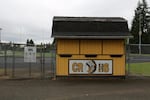Students at Columbia River High School in Vancouver, Washington, voted Thursday 79% in favor of keeping their Native American school mascot, the Chieftains.
Columbia River is the latest school in the Pacific Northwest to come under pressure to eliminate Native American-themed mascots.

Columbia River High School students decided to keep the Chieftain mascot after a campus-wide vote on May 16, 2019.
Molly Solomon / OPB
In a newsletter sent this month, school Principal Alex Otoupal said students would vote on the issue Thursday. Materials were made available before the vote, including a brief history of the school's mascot and the national debate over Native American mascots and sports team names.
The decision to raise the issue came from the students themselves. At a Feb. 2 Vancouver Public Schools Board meeting, six Columbia River High School students requested guidance for renaming the Chieftain mascot.
“It is our belief that it is time for this nickname to be retired,” said Zoe Luderman, a student and member of the school’s Social Justice and Awareness Club. “This image has been a misrepresentation of local Native American tribes and the school has perpetuated a negative image of these tribes through a number of thoughtless actions.”
Columbia River High School was founded in 1962. Its first graduating class selected the school colors and Chieftain mascot, a profile of a Native American man wearing a feathered headdress. Up until the 1990s, the school would select a student to dress up as a Native American and be the Chieftain of the year. At sports games, students would do a tomahawk chop fight song. One year someone even put up a teepee on the football field.
“We have reached a point where we can no longer even celebrate our image,” Columbia River student Arianna Bollens told school board members at the February meeting.
Students testified that they had consulted with leaders from the local Chinook and Cowlitz tribes, as well as current and former Native American students of the high school. They said the images made them uncomfortable at school and made it difficult for them to express school spirit. Some also called the mascot one-dimensional and stereotypical, noting its lack of connection to local tribes.
The school last reviewed the Chieftain mascot in 1994, after the Washington State Board of Education asked school districts to review Native American building names, mascots and logos for bias or derogatory connotations. A final report said the resolution prompted several schools to make changes and remove their mascots or logos. At the time, Columbia River High School decided to keep the Chieftains mascot, but "eliminated cartoon caricature portrayals and painted a new mural depicting a Pacific Northwest Indian."
The Washington education board passed a similar resolution in 2012, strongly encouraging districts to stop using Native American imagery. But the state directive is nonbinding and the board does not have the authority to force schools to comply.
Oregon has taken a stronger stance and in 2012 the state board of education voted to ban Native American mascots, nicknames and logos. It gave schools five years to comply. Eight Oregon school districts have been able to keep their Native American mascots by gaining support from local tribes.
While the vote to retire the Chieftains did not pass at Columbia River, the push did result in the Vancouver Public Schools board of directors adopting new policies for renaming school mascots. Previously, policies for renaming only applied to schools and buildings. The new rules lay out a process that would include input from community stakeholders and alumni.